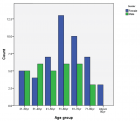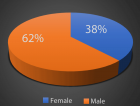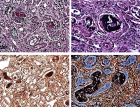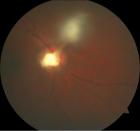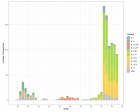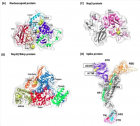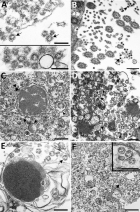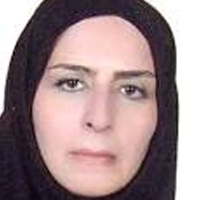Figure 7
COVID-19 New variant and air pollution relationship: how airborne mutagens agent can act on genoma viruses expression: Hypothesis of work
Luisetto M*, Naseer Almukthar, Gamal Abdul Hamid, Tarro G, Khaled Edbey, Nili BA, Ghulam Rasool Mashori, Ahmed Yesvi Rafa and Latyshev O Yu
Published: 16 February, 2021 | Volume 5 - Issue 1 | Pages: 022-031
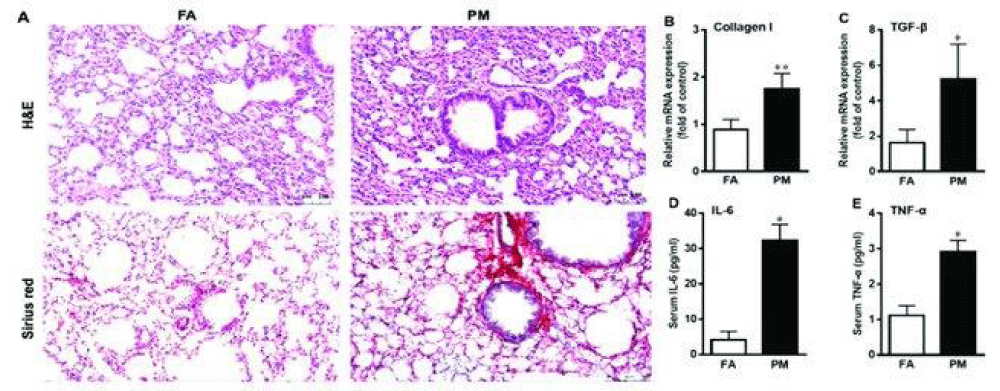
Figure 7:
PM2.5 exposure induces pulmonary- inflammation and fibrosis. (A) Lung sections from filtered -air (FA) and particulate matter (PM2.5)-exposed mice were stained with hematoxylin and eosin (H&E) and Sirius red staining at 200× magnification. (B-E) After exposure for 12 weeks, the mRNA- levels of fibrotic- genes collagen I and transforming growth factor β (TGF-β) in lungs (B, C) and the level of inflammatory factors- interleukin 6 (IL-6) and tumor necrosis- factor α (TNF-α) in serum (D, E) were measured by qPCR and enzyme linked immunosorbent- assay (ELISA) kits, respectively. Data are presented as mean ± standard deviation (SD); *p < 0.05, **p < 0.01 vs. FA group. Form TMT-Based Quantitative Proteomics Analysis Reveals Airborne PM2.5-Induced Pulmonary Fibrosis Dec 2018 International Journal of Environmental Research and Public Health 16(1):98 Follow journal DOI: 10.3390/ijerph16010098. Image from Vol-26, Number 9—September 2020 Synopsis.
Read Full Article HTML DOI: 10.29328/journal.ijcv.1001031 Cite this Article Read Full Article PDF
More Images
Similar Articles
-
COVID-19 New variant and air pollution relationship: how airborne mutagens agent can act on genoma viruses expression: Hypothesis of workLuisetto M*,Naseer Almukthar,Gamal Abdul Hamid,Tarro G,Khaled Edbey,Nili BA,Ghulam Rasool Mashori,Ahmed Yesvi Rafa,Latyshev O Yu. COVID-19 New variant and air pollution relationship: how airborne mutagens agent can act on genoma viruses expression: Hypothesis of work. . 2021 doi: 10.29328/journal.ijcv.1001031; 5: 022-031
Recently Viewed
-
Misoprostol Usage in the Kingdom of Bahrain: A Retrospective StudyMaryam Alsalem*,Hosni Malas,Gulmeen Raza,Rehab Ismael. Misoprostol Usage in the Kingdom of Bahrain: A Retrospective Study. Clin J Obstet Gynecol. 2025: doi: 10.29328/journal.cjog.1001196; 8: 092-095
-
Treatment Options for Congenital Dyserythropoietic Anemias (CDAs): Advances in Bone Marrow Transplantation, Gene Therapy, and Targeted TherapiesSophia Delicou*,Maria Moraki,Elena Papatheodorou,Aikaterini Xydaki. Treatment Options for Congenital Dyserythropoietic Anemias (CDAs): Advances in Bone Marrow Transplantation, Gene Therapy, and Targeted Therapies. J Hematol Clin Res. 2024: doi: 10.29328/journal.jhcr.1001031; 8: 027-033
-
Stability Duration of a Normal Control Pool for Prothrombin Time and Activated Partial Thromboplastin Time Prepared in the Hematology and Blood Bank Service of the Yaoundé University Teaching Hospital, CameroonMokou Claude Bertrand,Juste Patient Mbebi Enone,Toche Fotso Paul Senclaire,Koguep Ngongang Astride,Ngo Etoah Marie Claire,Makuete Lonkeng Alvine,Eyoum Bille Bertrand*,Tayou Tagny Claude. Stability Duration of a Normal Control Pool for Prothrombin Time and Activated Partial Thromboplastin Time Prepared in the Hematology and Blood Bank Service of the Yaoundé University Teaching Hospital, Cameroon. J Hematol Clin Res. 2025: doi: 10.29328/journal.jhcr.1001038; 9: 027-034
-
Coronaviruses have reached at Pre-elimination Stage with Nine Amino Acid Spike Deletions and Forty-nine Nucleotide 3’-UTR DeletionsAsit Kumar Chakraborty*. Coronaviruses have reached at Pre-elimination Stage with Nine Amino Acid Spike Deletions and Forty-nine Nucleotide 3’-UTR Deletions. Int J Clin Virol. 2024: doi: 10.29328/journal.ijcv.1001060; 8: 031-044
-
Feasibility study of magnetic sensing for detecting single-neuron action potentialsDenis Tonini,Kai Wu,Renata Saha,Jian-Ping Wang*. Feasibility study of magnetic sensing for detecting single-neuron action potentials. Ann Biomed Sci Eng. 2022: doi: 10.29328/journal.abse.1001018; 6: 019-029
Most Viewed
-
Feasibility study of magnetic sensing for detecting single-neuron action potentialsDenis Tonini,Kai Wu,Renata Saha,Jian-Ping Wang*. Feasibility study of magnetic sensing for detecting single-neuron action potentials. Ann Biomed Sci Eng. 2022 doi: 10.29328/journal.abse.1001018; 6: 019-029
-
Evaluation of In vitro and Ex vivo Models for Studying the Effectiveness of Vaginal Drug Systems in Controlling Microbe Infections: A Systematic ReviewMohammad Hossein Karami*, Majid Abdouss*, Mandana Karami. Evaluation of In vitro and Ex vivo Models for Studying the Effectiveness of Vaginal Drug Systems in Controlling Microbe Infections: A Systematic Review. Clin J Obstet Gynecol. 2023 doi: 10.29328/journal.cjog.1001151; 6: 201-215
-
Causal Link between Human Blood Metabolites and Asthma: An Investigation Using Mendelian RandomizationYong-Qing Zhu, Xiao-Yan Meng, Jing-Hua Yang*. Causal Link between Human Blood Metabolites and Asthma: An Investigation Using Mendelian Randomization. Arch Asthma Allergy Immunol. 2023 doi: 10.29328/journal.aaai.1001032; 7: 012-022
-
Impact of Latex Sensitization on Asthma and Rhinitis Progression: A Study at Abidjan-Cocody University Hospital - Côte d’Ivoire (Progression of Asthma and Rhinitis related to Latex Sensitization)Dasse Sery Romuald*, KL Siransy, N Koffi, RO Yeboah, EK Nguessan, HA Adou, VP Goran-Kouacou, AU Assi, JY Seri, S Moussa, D Oura, CL Memel, H Koya, E Atoukoula. Impact of Latex Sensitization on Asthma and Rhinitis Progression: A Study at Abidjan-Cocody University Hospital - Côte d’Ivoire (Progression of Asthma and Rhinitis related to Latex Sensitization). Arch Asthma Allergy Immunol. 2024 doi: 10.29328/journal.aaai.1001035; 8: 007-012
-
An algorithm to safely manage oral food challenge in an office-based setting for children with multiple food allergiesNathalie Cottel,Aïcha Dieme,Véronique Orcel,Yannick Chantran,Mélisande Bourgoin-Heck,Jocelyne Just. An algorithm to safely manage oral food challenge in an office-based setting for children with multiple food allergies. Arch Asthma Allergy Immunol. 2021 doi: 10.29328/journal.aaai.1001027; 5: 030-037

If you are already a member of our network and need to keep track of any developments regarding a question you have already submitted, click "take me to my Query."








